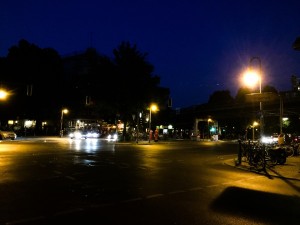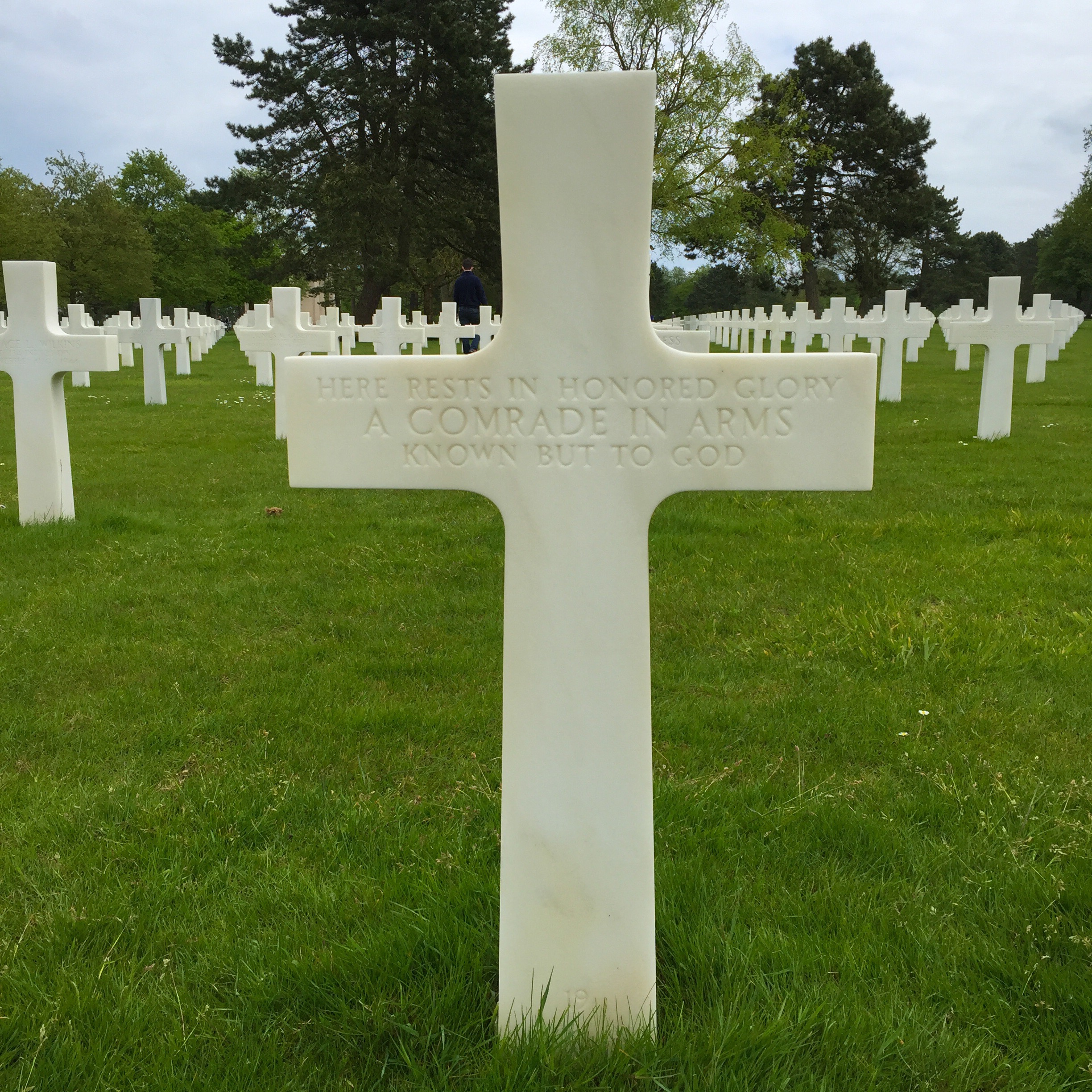 Like our visit to Poland, I found Berlin’s culture to be captivating. The language barrier between our group and the locals helped to solidify our thoughts of this “foreign” country, and remained ever-present on every street sign, menu, and doner-kebap advertisement. The “ß” is the most prominent departure from our English alphabet, and made pronunciation of the street of our hotel, “Stresemannstraße” nearly impossible without Dr. Davidson’s guidance. Another pinnacle of Berlin street signage is the adorable “Amplemann.” This bourgeois figure originated on Eastern German streetlights, but survived the fall of the wall and tells pedestrians when to walk throughout Berlin in present-day. These lights, which are unique to Berlin, are both whimsical and historical—like so much of the city.
Like our visit to Poland, I found Berlin’s culture to be captivating. The language barrier between our group and the locals helped to solidify our thoughts of this “foreign” country, and remained ever-present on every street sign, menu, and doner-kebap advertisement. The “ß” is the most prominent departure from our English alphabet, and made pronunciation of the street of our hotel, “Stresemannstraße” nearly impossible without Dr. Davidson’s guidance. Another pinnacle of Berlin street signage is the adorable “Amplemann.” This bourgeois figure originated on Eastern German streetlights, but survived the fall of the wall and tells pedestrians when to walk throughout Berlin in present-day. These lights, which are unique to Berlin, are both whimsical and historical—like so much of the city.
Immediately upon arrival to our hotel, I learned of how bike-friendly the city is. I almost was side-swiped by a bicyclist who rode on the city-mandated bike path that occupied 1/3 of the sidewalk. The bike path was present throughout the entire city, and I was surprised at just how often I heard bells alerting our large group to move out of the way. People of all ages and occupations could be seen commuting to and from work or otherwise taking advantage of the excellent transport option. Visitors are also encouraged to use the bike paths, and can rent bikes per day on various blocks around the city. I was cut off by a never-ending line of bicyclists one night in a remarkable exhibition of Berlin’s many bike riders. Hundreds of locals took charge on their bikes and continued on what must have been a loop around the city. This group, primarily composed of twenty-somethings, toted wagons with speakers, food, and even children during this biking festival. I watched at least a dozen riders impressively juggle steering and drinking beer as they whooshed down the streets of Berlin. This show of bikers inspired both a cacophony of car horns and a hint of spontaneity in the air. If I had not already fallen in love with the food here, I could tell this city-vibe would soon do the trick.
We visited many museums and memorials for our program, but also had a large amount of free time to explore the city. My dinner in the Görlitzer-Park area one night was a heavy contrast from what we had explored near Brandenburg gate. This neighborhood, on the East side of Berlin, was recommended by Dr. Davidson for those looking to be “adventurous.” When my friend Avery and I got off at the U-Bahn stop in this area, I instantly saw what he meant. Every building, and really any surface here, was completely covered with graffiti. This excited me, however, as it is exactly what I had hoped I would find in
covered with graffiti. This excited me, however, as it is exactly what I had hoped I would find in
Berlin. I loved looking at the beautiful and modern buildings in the center-city, but had longed to find a grittier and more colorful section that aligned with the city in my imagination. In the old area of East Kreuzberg, I found it. Every street in this city sported unique shops and restaurants that would make the most minor foodie drool. Signs for fancy burgers, goth bars, and even all-vegetarian plant themed joints were squeezed between vibrant arrays of artistic expression. The young and indie population also seemed unique amongst the vine and graffiti covered buildings. I felt that I had walked through a time machine when Avery and I wandered through Görlitzer Park and found so many groups scattered through the grassy pit who were picnicking, hula hooping, and even playing guitar. It was dusk by the time we decided to get dinner, and the streets we walked through were much darker than around Potsdamer Platz. Still, eclectic gastro-pubs and greasy diners illuminated the street with a subtle glow. We ate with a view of the U1 train line in sight, and enjoyed the exceptional food and drinks almost as much
population also seemed unique amongst the vine and graffiti covered buildings. I felt that I had walked through a time machine when Avery and I wandered through Görlitzer Park and found so many groups scattered through the grassy pit who were picnicking, hula hooping, and even playing guitar. It was dusk by the time we decided to get dinner, and the streets we walked through were much darker than around Potsdamer Platz. Still, eclectic gastro-pubs and greasy diners illuminated the street with a subtle glow. We ate with a view of the U1 train line in sight, and enjoyed the exceptional food and drinks almost as much as the diverse night-scene we observed while people watching. Like many of the European cities we’ve visited, the coveted sidewalk seats were in high demand as they provided the perfect viewing platform for the busy streets ahead. A Spanish guitar and piccolo duo performed in front of our restaurant, and we listened as bikers and Saturday night-goers bustled behind. The whole experience was charming, and left me with a youthful yet aged impression of Berlin.
as the diverse night-scene we observed while people watching. Like many of the European cities we’ve visited, the coveted sidewalk seats were in high demand as they provided the perfect viewing platform for the busy streets ahead. A Spanish guitar and piccolo duo performed in front of our restaurant, and we listened as bikers and Saturday night-goers bustled behind. The whole experience was charming, and left me with a youthful yet aged impression of Berlin.
 The next night, I returned to the area to view the East Side Gallery. I walked across the bridge above the Spree river, and quickly found the 1.3 km section of the Berlin Wall (painted in 1990 and restored in 2010.) The gallery, which is a section of the wall, can be viewed from the sidewalk. The murals of peace, political activism, and contempt for the wall itself were stunning in the yellow glow of the streetlights. It surprised me how quiet and accessible the wall was, although the occasional graffiti are combatted by rented guard rails in front of the art. When I viewed the gallery in the day, I noticed slightly more traffic to the wall and how vivid the colors and messages really were. My favorite quote from the gallery is “Wer will dass die welt so bleibt wie sie ist der will nicht dass sie bleibt,” [Erich Fried] which was kindly translated by the artist and reads: “He who wants the world to remain as it is doesn’t want it to remain at all.” This is clearly aimed at
The next night, I returned to the area to view the East Side Gallery. I walked across the bridge above the Spree river, and quickly found the 1.3 km section of the Berlin Wall (painted in 1990 and restored in 2010.) The gallery, which is a section of the wall, can be viewed from the sidewalk. The murals of peace, political activism, and contempt for the wall itself were stunning in the yellow glow of the streetlights. It surprised me how quiet and accessible the wall was, although the occasional graffiti are combatted by rented guard rails in front of the art. When I viewed the gallery in the day, I noticed slightly more traffic to the wall and how vivid the colors and messages really were. My favorite quote from the gallery is “Wer will dass die welt so bleibt wie sie ist der will nicht dass sie bleibt,” [Erich Fried] which was kindly translated by the artist and reads: “He who wants the world to remain as it is doesn’t want it to remain at all.” This is clearly aimed at

Picasso’s “Guernica” (which depicts the devastating fire-bombing of the named town during the Spanish Civil War) reimagined in terms of Berlin
the communist occupiers of Berlin during the wall era, but it reminded me of lessons we’ve learned about the lead up to WWII. Indifference can be just as horrible of a culprit as aggression, and utter control at the expense of individuality and progress is detrimental to the human experience. After WWII, the German people’s change towards utter democracy (on the West End) was embraced much more fervently than during the period of the Weimar Republic. People sought more freedom and power, and their devotion to democracy can even be seen in the architecture of the renovated Reichstag building. The transparency of their government is mimicked in the glass designs, and care was taken to ensure the “people” would be on the same le vel of their representatives. The generation after the war wanted their world to change, and saw through that it happened. This is starkly different from Soviet occupied Berlin, which switched from one totalitarian state to another. In Fried’s quote I found a warning that can be followed even in the present day. Future generations must be willing to accept and contribute to social change in the name of what is right, and cannot stand idly by to accept what is comfortable.
vel of their representatives. The generation after the war wanted their world to change, and saw through that it happened. This is starkly different from Soviet occupied Berlin, which switched from one totalitarian state to another. In Fried’s quote I found a warning that can be followed even in the present day. Future generations must be willing to accept and contribute to social change in the name of what is right, and cannot stand idly by to accept what is comfortable.
I was sad to say Auf Wiedersehen to my friends and professors last night, but found Berlin to be a beautiful place for such goodbyes. I’ve enjoyed every minute of the past month, and am incredibly grateful for this opportunity. I’m writing now on my bus to Prague, where I hope to begin my next adventure.










